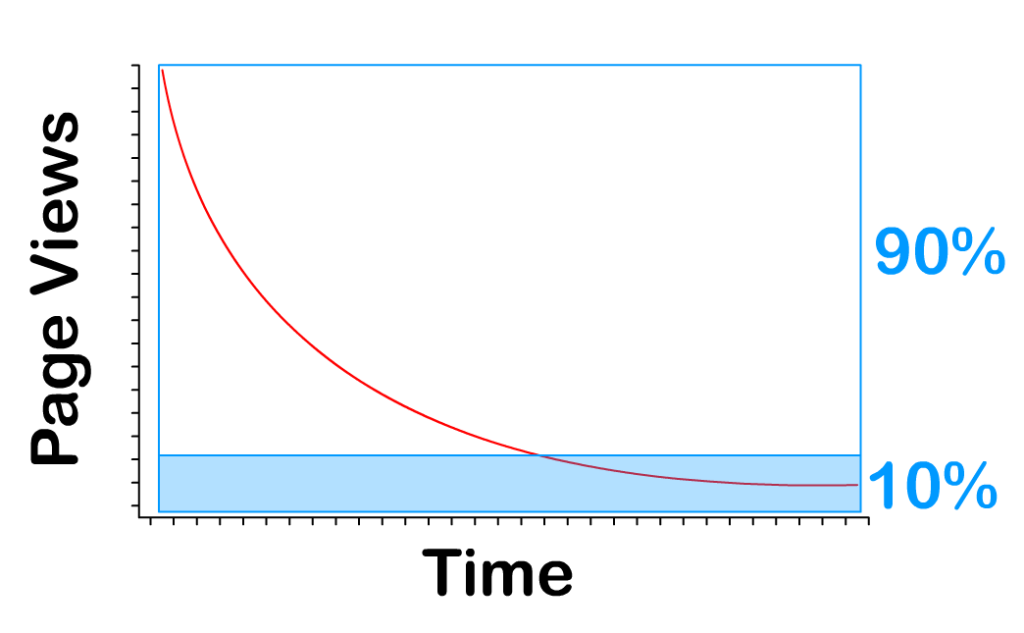Learning to repurpose content to create new materials is an excellent way to get the most out of every piece of content you produce.
That said, it’s not always possible to tell when you should be recycling older content.
Luckily, there are some simple metrics that you can rely on to tell you when audiences are ready for more on a certain topic.
Here are three metrics you should use to guide your content repurposing efforts:
1. Page Views
Watch for when page views dry up – they’ll be your first indicator that content is ready to be recycled.
- When content is no longer bringing in a profitable audience, it shouldn’t be left to gather dust.
- Instead, find ways to make use of it in a different format to draw crowds back in or reward your regular visitors.
The page view metric is useful for a variety of reasons.
- It lets you know which content is performing well and which might be less popular.
- It indicates how well your site is drawing in readers over time.
Each piece of content you produce will eventually decline in popularity as it gets buried in the bowels of your site.
- This might be because it’s no longer being displayed on your homepage.
- It might not get much attention on social media as new content is released.
- You might simply get to the point where the majority of your audience has already viewed it.
As your content’s popularity drops over time, you’ll see your page views level out to the point that they’re bringing in nowhere near as much traffic.
At the point where your content’s page views are approximately 10% of what they were at their peak, it’s time to begin planning how to reuse or repurpose your content.
By the time your content is regularly at just 5% of its peak page views, it’s been seen by the majority of people who will ever see it.
This is the time to release a repurposed or altered version of your content to make use of its potential in other forms.
Waiting until content has only a fraction of its former page views ensures that you’re making the best possible use of your resources while something is still popular.
It also makes sure you’re not bombarding your audience with the same message over and over when a large chunk of your potential customers still remember your first use of the content.
Different Content Needs Different Treatment
It’s important to note that every piece of content will have a unique curve on the graph of page views over time.
- Some content will have an enormous initial traffic surge which drops off quickly.
- Other content might not have quite such a strong start, but will keep bringing in relatively solid traffic for longer.
If content is constantly pulling in good numbers, it doesn’t need to be reworked as quickly as content with a shorter shelf-life.
- Instead, find ways to draw attention to evergreen content in its current form, and wait until its popularity drops lower before reworking it.
- Focus on content that’s been forgotten or which isn’t bringing in traffic to help make full use of its potential, even if it’s temporarily not helping your content marketing efforts.
It will of course also depend on whether a subject suddenly becomes a point of discussion within your industry (more on that a little later).
What to Do With This Content
When you’re dealing with content that’s dropped in popularity, I like to find a way to repurpose it in a way that plays to its strengths.
This can mean reusing it in a different format to try to draw in different audiences or remind existing viewers of a message they might have forgotten about.
For example, my text content can be reworked into a variety of different formats:
- Blog articles can form the basis of white papers, eBooks, or email newsletter resources.
- This involves minimal re-writing, but gives you an entirely new form of content that you can use to draw in crowds without much additional effort.
This will help you to make full use of your assets without spending too much time working on content that your audience has already enjoyed but mostly forgotten about.
2. Social Media Mentions
This metric isn’t one that you control on your own end, but instead comes from reading the stats for the popularity of certain keywords online.
By paying careful attention to what’s going on with social media, you can predict when a wider audience might be ready to see some of your older content return.
Trending topics on social media indicate the subjects that people are discussing, and can give you an indicator of what your audience is ready for.
There are a variety of tools online that can help you keep tabs on trending topics so that you can spot when buzz starts to develop around a subject you’ve covered in previous content.
- For example, Trackur is a tool I’ve used that breaks down the popularity of certain keywords and topics to help you spot when something might become a talking point.
- You can use this to monitor relevant subjects so that you’re ready in a moment’s notice to respond to key changes in the discussion throughout your industry.
- You can also see when subjects are rising in popularity over several days to help predict what might become a talking point in the near future.
- With tools like this you can spot when a lot of new people are discussing a topic all at once (the ‘New Results’ metric).
- You can also see a graph of how your chosen keywords measure up over the past seven days.
- You can even spot which social media outlets are driving the discussion, which is useful for deciding how you’ll go about advertising your repurposed content.
It’s useful to supplement the social mentions metric by keeping an ear to the ground relating to your industry.
- When a keyword starts gaining popularity, try to find out what new development the discussion is revolving around.
- This will help you to make best use of your repurposed content.
Through carefully reading the stats behind social media, you can spot an excellent opportunity to bring your old content back into vogue.
What To Do With This Content
When looking to take advantage of trending topics, time is of the essence.
- The earlier you can jump in to the discussion to promote your own content, the more you’ll influence the direction that the discussion takes.
For that reason, when repurposing content that’s on a subject that is trending, you want to do so as quickly as possible, giving your content a quick pit stop before it hits the road again.
- There’s no need to pause to produce a high quality adaptation of the content into another form.
- Instead, you want to re-release it quickly and focus your attentions on publicizing it across social media.
- Don’t worry about annoying your existing audience with the same content again, as your primary aim here it to attract audiences who might not have seen it the first time but who are interested in the subject matter thanks to the new boost in the discussion.
The best way to repurpose this content is to add a preface or some kind of commentary to tie it into the reason the topic is trending.
- If a new development has occurred in your field to make the subject relevant, spend some time talking about what this means for your earlier argument, or point out why your content is helpful in understanding what’s going on.
- Be sure to point out that you’re re-releasing old content: the age of your materials help your reputation as it shows that your company is ahead of the curve when it comes to trending topics.
Once you’ve prepared these brief changes to your content, it’s time to start distributing it widely.
- Thanks to your research into social media sharing metrics, you should be able to spot which websites or social media profiles are doing the best job of reporting on the discussion.
- Target these through the inclusion of similar hashtags or simply messaging them directly, to make sure your content gets in front of influencers in your field.
- Send your content out to every area of social media that is debating your topic, in order to get stuck right into the middle of the discussion.
Through keeping an eye on social media mentions for keywords relating to your old content, you can repurpose work that will help you to ride new trends as and when they occur.
Just don’t try too hard to squeeze older content into the wrong discussions – pick your battles and make sure your content is definitely relevant to the subject that’s trending.
3. Time On Site
Page views and social media trends are a good indication of how popular certain topics are, but content marketing is about more than just drawing people onto your site.
- Your goal is to help push people towards engaging with your company and making purchases.
- This means you need audiences not only to visit your site, but to take in your message in its entirety.
There are a lot of metrics that indicate how well your content is actually reaching audiences, but the one I’d recommend paying attention to when you’re considering repurposing content is the time your visitors spend on your site.
- This metric can be tracked simply and easily in Google Analytics, which will give you an overview of how long visitors spend on your site on average each day.
This is useful as you can see how well your entire site is doing at keeping users interested, but for the purposes of learning which content should be repurposed, it’s better to look at a breakdown of each individual page on your site.
With this view, it’s possible to spot how popular pages on your site are, compared against how long visitors are actually spending on each page.
- From this, you can work out which content is good at drawing audiences in, but isn’t doing too well at keeping visitors engaged.
- This indicates that content, while effective to a certain degree, is missing out on its potential by not giving visitors enough to sink their teeth into.
Content that looks appealing but that is failing to keep people entertained is perfect for repurposing.
- You already know that the subject matter is drawing in crowds.
- All you need to do is try it in a different format to see whether you can increase its impact on your audience.
As you repurpose popular but unengaging content, you ensure that site visitors stick around longer, increasing the chances that they’ll follow through on calls to action which will lead them to sales.
What to Do With This Content
In picking a direction for your content, it’s worth considering the variety of formats that it can easily be adapted to.
The most notable content type when looking to increase time spent on your site is video, although other multimedia content types work too.
- The presence of video content has been proven to extend the amount of time people spend on a website by as much as two minutes.
- What’s more, shoppers are 81 times more likely to make a purchase after watching video content.
Repurposing text or video content as a video marketing is relatively simple – the text can serve as the script for the video, and the images can be used to give the video visual appeal.
It’s also possible to improve audience behaviour and time on site from repurposing content as infographics and other visuals – anything which gives the visitor something other than a wall of text is going to work out well.
Waste Not, Want Not
These three metrics are good indicators of when your audience is ready to revisit old content in new forms so that you can get the most out of your back catalog of materials.
That said, if you’re ever in doubt as to whether or not you should adapt something, I say go for it. It never hurts to have more content on your site, even if it’s adapted from existing resources.
When do you think it’s time to repurpose content? Is there such a thing as too much recycling? Share your thoughts in the comments below.
Images: Wikipedia, Pixabay, Twitter, Trackur, Pixabay, Google Analytics, Pexels.
















